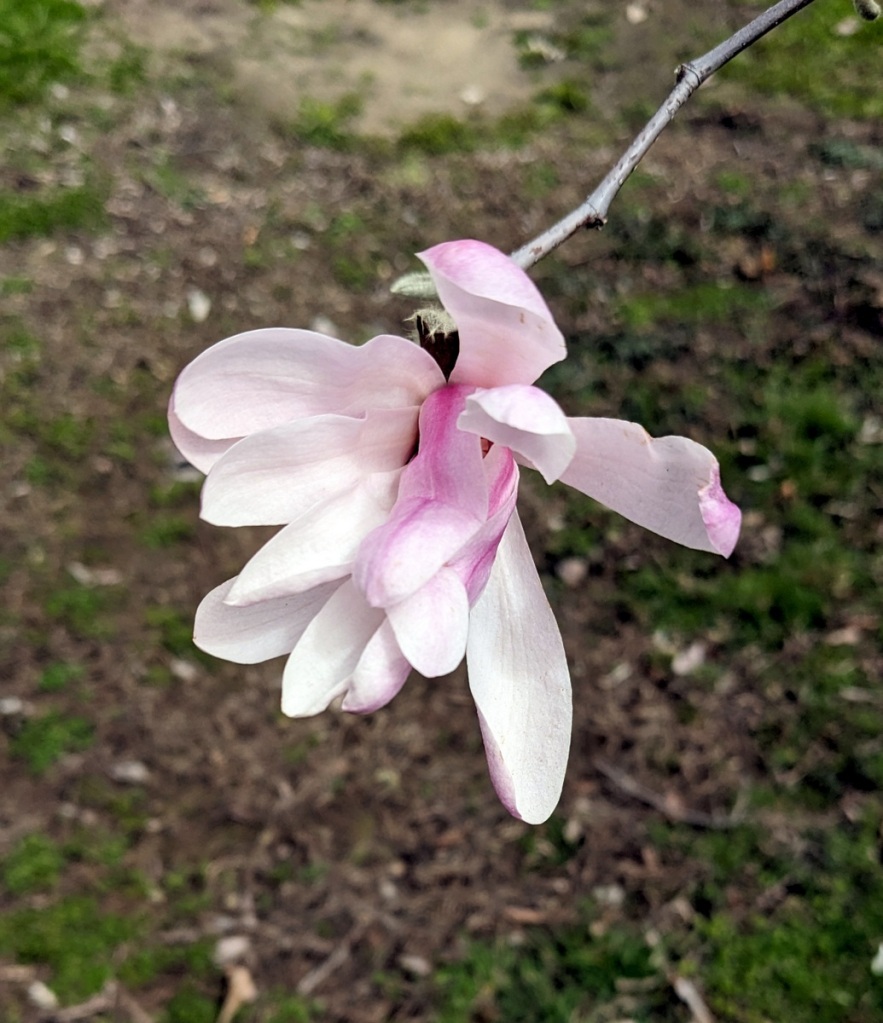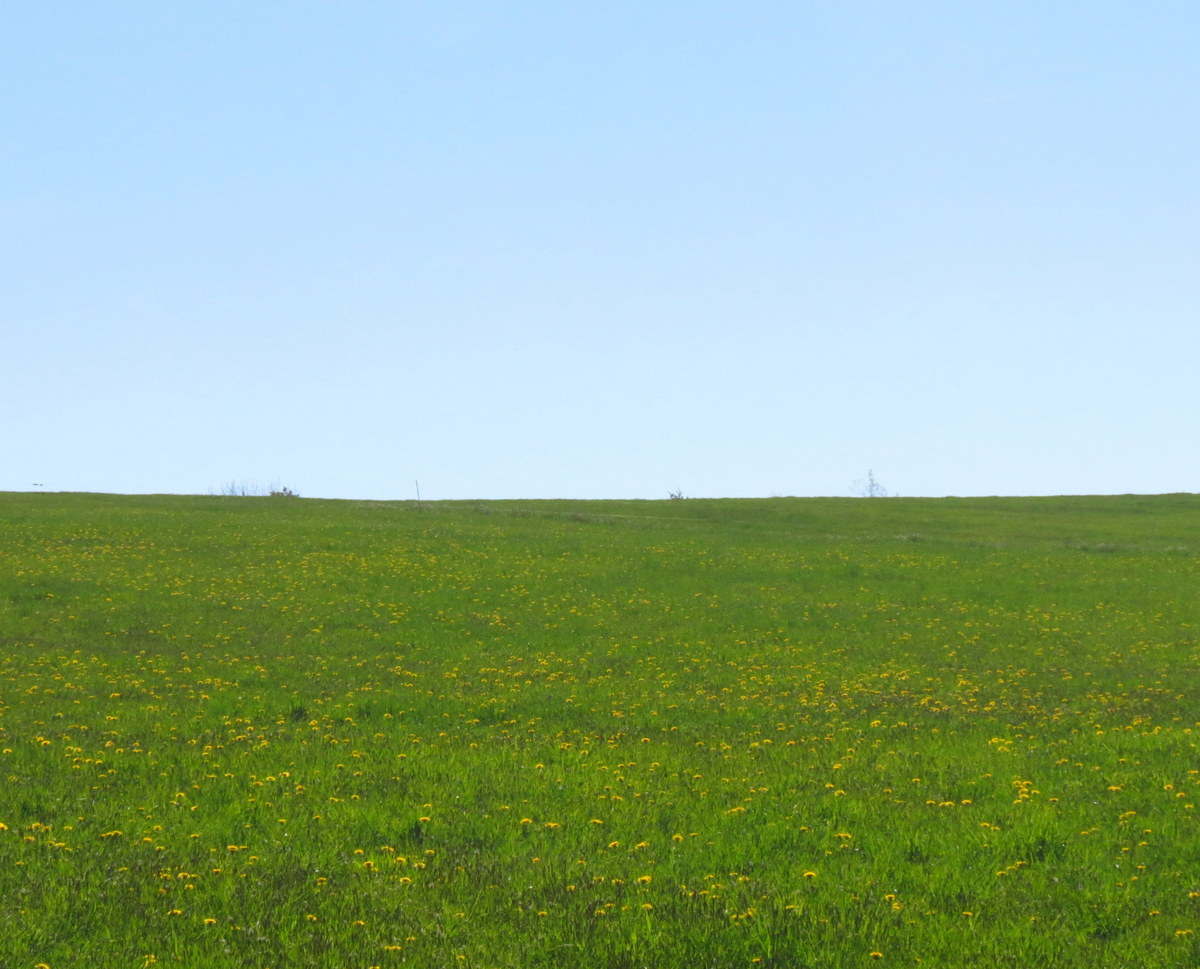
More glory of the snow flowers have come along. This is another under used spring flowering bulb that I can find only in one spot in a local park. I think it must be another of those flowers that people simply aren’t aware of. It’s too bad we don’t have a public garden here where people could go to learn the names of flowers they like and to see how they can be used in a garden.

It’s already time to say goodbye to the crocuses. They were beautiful this year despite the snow and cold they went through.

New flowers have taken over for the crocuses. Hyacinths and daffodils dominate this bed at the local college. I wish I could add fragrance to photos.

Most of the daffodils are in full bloom now. This one was fading a bit already but it was still pretty.

Bleeding hearts are up. These are the tall old fashioned bleeding hearts that disappear in the heat of summer. I like their spring foliage but sometimes it can be hard to catch it in this stage because it grows so fast. These plants will be blooming in no time.

Scilla blossoms are at their peak right now and since they’re my favorite color, I’m happy that they are. This spring bulb always looks better planted in large numbers, as these were.

I think it’s safe to say that lilacs are going to have a great year. As long as we don’t have another freeze, that is.

The Japanese magnolia buds that I showed in the last post have opened. As I mentioned they are this plum color outside….

…and white on the inside. As I also said, the petals tend to flop around a lot.

Violas seem tired this year. I can remember plants full of flowers but these plants at the local college are getting old so they can only manage one or two blooms at a time now. They were show stopping when they were in their prime.

It’s getting to be time now for the flowering shrubs and trees to add to the beauty. Japanese andromeda are one of the first shrubs to bloom and this year they are heavy with flowers that look like tiny fairy lights mounted in gold. They must like mild winters; I’ve never seen them bloom like they are now.

Once just by dumb luck I took a photo of a henbit flower and saw lots of hairs that I couldn’t see with my eyes, so every now and then I try for the hairs. This shot is this year’s the result. It’s a tiny but very hairy flower. It’s in the deadnettle family and some call it henbit deadnettle. The red parts seen under the hood are its four stamens. It has two long and two short stamens, much like ground ivy. I’ve read that its name comes from the way hens peck at the flowers but it isn’t the flowers they’re after; it’s the four tiny seeds the flowers produce.

Dandelions haven’t stopped since February. It seems like each time I go out I see even more. Many this year have had huge flowers on them but I’d say these were average.

I went to the wetlands hoping I might see some dragonflies but it must have been too early. I did see some red maples shining in the morning sunlight though, and they were beautiful. I also saw a small orange butterfly but it was too quick for me.

I sat on a picnic table on the side of the road and this bird flew into a bush beside me. Google lens says it’s a song sparrow but I wonder, because it squawked but didn’t really sing. Last year while I was sitting on the same picnic table a bird that looked like this one flew into the same bush, but that one sang beautifully.

When I got up to leave after sitting for a while I saw that a muskrat had come up out of the pond to eat some of the fresh green grass shoots. Its front paws looked just like little hands but with long claws. Muskrats must be famished for something green in spring; I’ve seen them do this once or twice before but it’s rare to see one expose itself in daylight when people are around. Muskrats can be aggressive if they feel threatened, so it’s best to give them plenty of space.
Muskrats are smaller than beavers and their ears are small, flat against the head and hard to see while a beaver’s ears are larger, protruding, and easy to see. The tails are the best way to tell them apart but the tail isn’t always visible. A muskrat can curl its rat like tail around its body as this one had but I don’t think beavers are able to do this with their longer, flat tails. Any time I’ve seen a beaver on dry land its tail was obvious.

On Tuesday it reached 70 degrees F. and the turtles came out in large numbers to soak up some warmth. At first I thought I was seeing just that larger turtle but then I moved a little and saw another one behind it. Then I got home and looked at the photo and saw another one coming out of the water. The scene looked like they had wrecked a bamboo raft and were scrambling to safety but it was really just last year’s cattail stems scattered around. While I was getting shots of turtles I heard a deep throated bullfrog croaking off in the distance; the first I’ve heard this year.

I think the mourning doves have been taking turkey lessons, because as I walked down a road recently I watched two doves stopping traffic. Anyone who knows these birds knows how skittish they can be but this particular pair were so interested in something in the road, they had no fear. A car came along at speed but the driver had to hit the brakes, letting the car creep along until the doves moved slowly out of the way, just as turkeys do. After taking a couple of shots I kept walking, but when I looked back there they were again, right back in the middle of the road. I’ve read that the name “mourning” dove comes from the mournful sound they make.

Willows were absolutely glowing on a recent cloudy day. I was surprised because they were female flowers, which in willows aren’t as showy or as brightly colored as male flowers.

This is what the female (pistillate) flowers look like. They’re smaller, paler, and obviously evenly spaced.

This is what the male (staminate) flowers look like. They’re a bright, banana yellow and are bigger than the female flowers. Though they are also evenly spaced it isn’t readily apparent. They often look kind of chaotic and one sided.

I went to see how the hobblebush flower buds were coming along. They aren’t very big yet because they bloom in May but they’re bigger than the last time I saw them. Each flower bud is between two young leaves that look like they’re made of corduroy. They are in their bunny face mode right how but soon the leaves will flatten out and uncurl and the beautiful snow white flowers will start to open. Hobblebushes are one of our most beautiful native viburnums.

The male flower bud scales on box elders have opened to reveal the reddish brown colored stamens within. They should grow quickly out of the buds now, and before long each stamen will dangle at the end of a long filament. A week or so after they have fully developed, the female flowers, which are sticky lime green pistils, will appear along with the leaves. Box elder flowers are quite beautiful but since the trees are considered “weed trees” they are becoming increasingly hard to find and get close to. Box elder is in the maple family and is considered one of the “soft maples.” The oldest intact Native American flute ever found was made from box elder.

Next time you’re walking under a tree why not stop for a moment and reach up and pull down a branch? Just take a look at the buds; it takes little effort and even less time, and you might be amazed that you have been walking right by something so beautiful for so long. These slightly hairy, richly colored Norway maple buds are about at their peak of beauty right now. Soon they’ll open and large clusters of yellow flowers will spill out of them. Norway Maple is actually an invasive tree but so many towns and cities have planted them as landscape specimens, it’s far too late to do much about it now. I find them in the woods fairly regularly.
Every bird, every tree, every flower reminds me what a blessing and privilege it is just to be alive.
~Marty Rubin
Thanks for stopping in.




































































































































































































